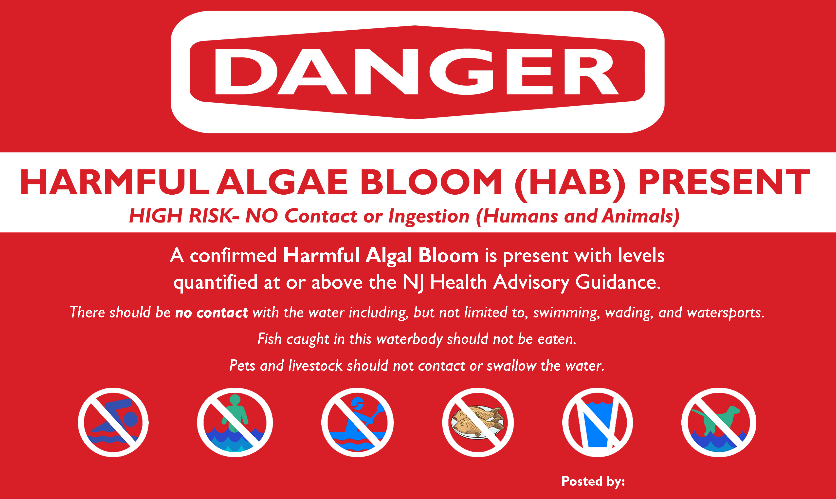|
FOR IMMEDIATE RELEASE |
Contact: Lawrence Hajna (609) 984-1795 |
|
PUBLIC ADVISED TO AVOID SWIMMING OR COMING IN CONTACT WITH WATER IN NEW JERSEY PORTION OF (19/P059) TRENTON –The New Jersey Department of Environmental Protection is advising the public to avoid swimming in or coming in contact with water in the New Jersey portion of Greenwood Lake following water monitoring and aerial remote-sensing surveillance today that confirmed the extensive presence of a Harmful Algal Bloom, or HAB. There is no scientifically sound treatment to eliminate HABs from water bodies, so advanced and continuous monitoring is the key element in protecting health and assessing when the lake is safe for swimming and recreational activities.
The DEP and the New Jersey Department of Health have also advised the closure of public swimming beaches on the lake in New Jersey. The DEP is working closely with the New York Department of Environmental Conservation. The nine-mile-long lake straddles Passaic County in New Jersey and Orange County in New York. Exposure to cyanobacteria, which causes Harmful Algal Blooms, can result in a range of health effects, including rashes, allergy-like reactions, flu-like symptoms, gastroenteritis, respiratory irritation and eye irritation. Symptoms can occur in sensitive individuals even at levels below the New Jersey Health Advisory Guidance. The New Jersey Health Advisory Guidance recommends the public avoid swimming in or coming in contact with water when cell counts are greater than 20,000 cells per milliliter or microcystin levels are above 3 micrograms per liter. DEP monitoring indicates both cell counts and microcystin levels are above the guidelines. Exposure to a Harmful Algal Bloom that is actively producing cyanotoxins may result in more serious health effects, including liver toxicity and neurological effects. If members of the public suspect a bloom, they should avoid any contact with the water and contact the DEP’s hotline at 877-WARN DEP (877-927-6337). The DEP will continue to monitor water quality through sampling and aerial surveillance. Updates will be provided to the public. It is difficult to predict how long a Harmful Algal Bloom will last. For information on Harmful Algal Blooms and DEP testing and aerial surveillance data, visit www.state.nj.us/dep/hab/ Cynobacteria are naturally present in lakes and streams in low numbers. Under suitable environmental conditions – sunlight, high nutrients, warm temperatures and calm waters – dense cyanobacterial blooms may form. The bacteria may proliferate to unhealthful levels when nutrients are carried by runoff from rainfall into water bodies, followed by periods of warm weather. Primary sources of nutrients include fertilizers, septic systems and animal wastes. This is the second major recreational lake in northern New Jersey to be placed under a swimming and contact advisory this summer. Lake Hopatcong, to the south, remains under a similar advisory that has been in place since June 27. The DEP’s aerial remote sensing of Greenwood Lake detected estimated levels of phycocyanin, a pigment present in cyanobacteria and correlated to cell counts, in the New Jersey portion of the lake that are above the state’s Health Advisory Guidance. DEP testing of water samples from the lake confirmed those estimates. HABs, also known as blue-green algae, are usually a bright green, but can also appear as spilled paint, “pea soup,” or as having a thick coating or “mat” on the surface. They may also be present in the water column below the surface. In recent years, the DEP and the New Jersey Department of Health have been enhancing Harmful Algal Bloom surveillance and response efforts across the state. In 2017, the DEP launched a campaign to educate the public about these blooms and provide resources on how to report them to the DEP. The “Avoid It and Report It” campaign advises the public to take the following steps when a suspicious bloom is observed:
### |
|
 The DEP’s advisory urges the public to avoid swimming or water sports that may result in contact with the water, such as water-skiing, tubing, canoeing and kayaking. There is no recommended limitation on fishing or passive recreational boating that does not have the potential for splashing. However, fish caught in the New Jersey portion of the lake should not be eaten. The public is further advised that pets should not be allowed in the water or to drink it.
The DEP’s advisory urges the public to avoid swimming or water sports that may result in contact with the water, such as water-skiing, tubing, canoeing and kayaking. There is no recommended limitation on fishing or passive recreational boating that does not have the potential for splashing. However, fish caught in the New Jersey portion of the lake should not be eaten. The public is further advised that pets should not be allowed in the water or to drink it.